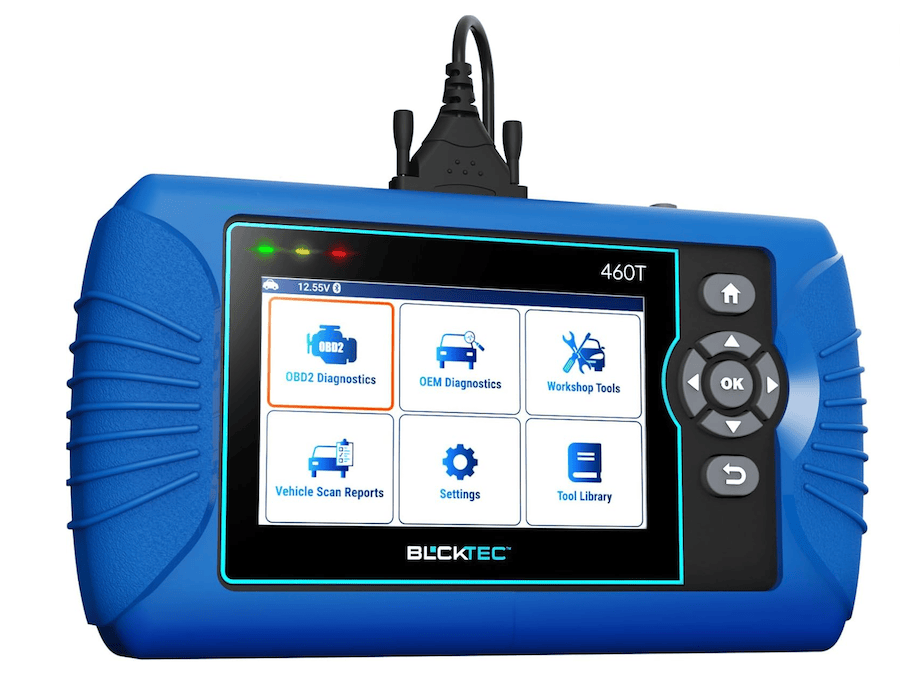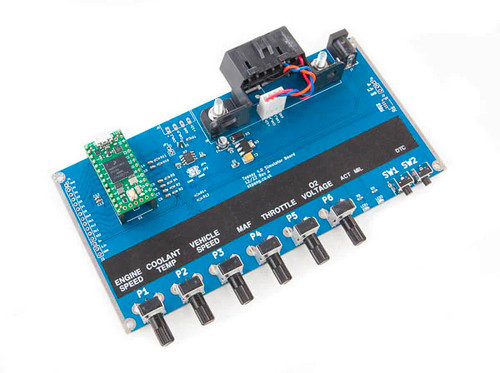Blog
Recent Posts
BLCKTEC 460T OBD2 Scanner Review: A Powerful All-System Diagnostic Tool for Serious DIYers
Posted by on
 If you maintain your own vehicle or manage a small repair operation, having a capable diagnostic tool is essential. The BLCKTEC 460T OBD2 Scanner is one of the more advanced consumer-level devices on the market, offering all-system diagnostics, service reset functions, and live-data graphing. Below, we’ll explore what this tool can do, how it performs, and whether it’s worth adding to your automotive toolkit.
If you maintain your own vehicle or manage a small repair operation, having a capable diagnostic tool is essential. The BLCKTEC 460T OBD2 Scanner is one of the more advanced consumer-level devices on the market, offering all-system diagnostics, service reset functions, and live-data graphing. Below, we’ll explore what this tool can do, how it performs, and whether it’s worth adding to your automotive toolkit.
What Is the BLCKTEC 460T?
The BLCKTEC 460T is a handheld automotive scanner designed to communicate with any OBD2-compatible vehicle (1996+ in the U.S. and Canada). It goes well beyond simple code reading, providing full-system capabilities including Engine, Transmission, ABS, SRS, and various maintenance resets.
Unlike basic readers, the 460T functions more like a compact diagnostic tablet, complete with intuitive menus, AutoVIN detection, and multi-channel data graphing.
Key Features
1. All-System Diagnostics
The scanner can read, diagnose, and clear codes across major vehicle systems:
-
Engine
-
Transmission
-
Anti-lock Brakes (ABS)
-
Airbags / SRS
This makes it far more capable than entry-level OBD2 readers, which typically only cover the engine control module.
2. 12+ Service Reset Functions
Useful for DIY maintenance and workshop tasks:
-
Oil Light Reset
-
EPB (Electronic Parking Brake) Reset
-
Steering Angle Sensor Calibration
-
DPF (Diesel Particulate Filter) Regeneration
-
Throttle Body Relearn
-
TPMS Relearn
-
Battery Reset / Initialization
These functions can help avoid dealership service fees for routine resets.
3. Live Data & Graphing
The BLCKTEC 460T provides:
-
Real-time data streams
-
Freeze-frame data
-
Multi-PID graphing
This is essential for diagnosing intermittent faults, tracking sensor behavior, and validating repairs.
4. AutoVIN & AutoScan
The scanner automatically:
-
Detects the Vehicle Identification Number
-
Scans all available ECUs
-
Identifies supported systems and functions
This greatly speeds up diagnostic workflows.
5. Free Lifetime Updates
The manufacturer promises free software updates, extending the tool’s useful lifespan and ensuring compatibility with newer vehicles.
Why This Scanner Stands Out
Advanced Capabilities for DIY Technicians
Users who work on their own vehicles will appreciate having dealer-style reset functions and all-system scanning at an accessible price point.
Excellent Value Compared to Shop Diagnostics
One dealership diagnostic session can cost more than the scanner itself. For multi-vehicle households or hobbyists, the investment pays for itself quickly.
User-Friendly Interface
Despite its advanced functions, the touchscreen interface makes navigation intuitive. Even first-time scanner users will find it approachable.
Ideal for Small Repair Shops
Shops that service a wide range of vehicles can benefit from the broad compatibility and multi-system support.
Potential Limitations
Compatibility Varies by Manufacturer
Not all service resets are supported on every make/model. This limitation is common across all aftermarket scanners.
Not a Full Professional Shop Tool
It doesn't offer:
-
ECU programming
-
Advanced bi-directional control on all models
-
Factory-level coding features
For most DIY and light-professional scenarios, however, it provides more than enough capability.
Learning Curve
The wide feature set may require some time to master, especially for users accustomed to basic readers.
Who Should Consider the BLCKTEC 460T?
This scanner is a great fit if you are:
-
A DIY mechanic who handles regular maintenance
-
A small garage or mobile mechanic needing all-system capability
-
A vehicle enthusiast who wants deeper diagnostic insight
-
A family with multiple cars, especially older ones with recurring issues
It may not be necessary if all you need is a simple code reader to clear the occasional check-engine light.
Conclusion
The BLCKTEC 460T is a capable, well-rounded OBD2 scanner that brings professional-level functionality into the hands of everyday drivers and independent mechanics. Its mix of all-system diagnostics, live data, and service resets makes it a strong choice for anyone looking to take control of vehicle maintenance.
If you're looking for a scanner that does far more than basic code clearing—and at a price point that won’t break the bank—the BLCKTEC 460T deserves a spot on your shortlist. More information...
Teensy 4.0 OBDII CAN-Bus ECU Simulator Includes Teensy 4.0
 This simulator from Copperhill Technologies delivers an impressive plug-and-play platform built around the Teensy 4.0 microcontroller—already installed and ready to go. It emulates a vehicle’s ECU over the standard OBD-II CAN bus (ISO 15765-4, 11-bit, 500 kbps) via a full-sized female OBD-II connector, complete with built-in potentiometers (six of them) for live on-the-fly adjustment of key parameters such as engine RPM, throttle position, coolant temperature, vehicle speed and more. The board requires a 12 V power supply (included) and features open-source firmware so you can modify or extend functionality freely.
This simulator from Copperhill Technologies delivers an impressive plug-and-play platform built around the Teensy 4.0 microcontroller—already installed and ready to go. It emulates a vehicle’s ECU over the standard OBD-II CAN bus (ISO 15765-4, 11-bit, 500 kbps) via a full-sized female OBD-II connector, complete with built-in potentiometers (six of them) for live on-the-fly adjustment of key parameters such as engine RPM, throttle position, coolant temperature, vehicle speed and more. The board requires a 12 V power supply (included) and features open-source firmware so you can modify or extend functionality freely.
What makes it especially compelling for developers, educators and advanced hobbyists is its mix of realism and flexibility. Instead of simply reading codes or replicating generic outputs, you can simulate realistic sensor changes, diagnostic trouble codes (DTCs), freeze-frame data, and full OBD-II Mode 01/02/03 operations—without having to connect to and run an actual vehicle. That makes it ideal for testing OBD-II software, building telematics or diagnostic tools, training in automotive electronics, or prototyping CAN-bus applications safely in the lab. More information...
Farmers Are Hacking Their Tractors Because of a Right to Repair Ban
For decades, American farmers have been at the mercy of agricultural equipment manufacturers, who have locked down their tractors with proprietary software, restricting repair options and forcing owners to seek expensive, manufacturer-approved service providers. In response, a growing number of farmers are resorting to hacking their own tractors, using underground software tools and firmware modifications [...]
Understanding SAE J1939 and Telematics
SAE J1939 is a high-level communications protocol standard widely used in the commercial vehicle industry. Developed by the Society of Automotive Engineers (SAE), it is primarily utilized for communication and diagnostics among vehicle components and systems, including engines, transmissions, and braking systems. When integrated with telematics, SAE J1939 unlocks new possibilities for vehicle monitoring, diagnostics, [...]
Copperhill Technologies and Their J1939 Gateways
Copperhill Technologies is a company known for providing high-quality, reliable networking solutions for industrial and transportation applications. Among its range of offerings, their J1939 gateways stand out as key components for connecting devices that use the SAE J1939 protocol, a standard that is integral to modern heavy-duty vehicles and industrial machinery.Understanding SAE J1939 The SAE J1939 [...]
PiCAN CAN Bus HATs - Powerful and Versatile Add-Ons for the Raspberry Pi
The PiCAN series of boards are widely recognized as powerful and versatile add-ons for the Raspberry Pi, enabling seamless integration with the Controller Area Network (CAN) bus. Originally developed for automotive applications, the CAN bus has become a standard communication protocol in industries such as industrial automation, robotics, and healthcare due to its robustness and efficiency. [...]
JCOM1939 Monitor Software - A Critical SAE J1939 Diagnostic and Analysis Tool
The JCOM1939 Monitor Software is a specialized tool designed to interface with and monitor data on the SAE J1939 communication network. SAE J1939 is a standardized protocol commonly used in heavy-duty vehicles, agriculture equipment, and industrial machinery for onboard diagnostics and data communication. This essay explores the features, applications, and significance of JCOM1939 Monitor Software in [...]
OBD2 Bluetooth Scanner with App for iOS & Android
The V011 OBD2 Scanner provides a complete diagnostic solution, thoroughly understanding your vehicle's condition. It supports a variety of performance tests, including fast reading of DTCs, access to electronic emission readiness, turning off the CEL or MIL, resetting monitors, reading live data, retrieving the vehicle's VIN, checking battery health, accessing freeze frame data, reviewing sensor data, [...]
Diesel Diagnostic Scan Tool for J1587/J1708, J1939 Trucks
The KZYEE KC601 scanner module is the newest portable heavy-duty vehicle code reader. It can quickly and efficiently read DTCs in the truck's electrical control system, diagnose the fault location, and find the cause of the fault. It is beneficial for all auto repair shops to read and clear fault codes and read live data. The scanner [...]
Mining Machinery Telematics - Fuel Monitoring, Diagnostics
Powerful engines of mining machinery consume large amounts of fuel and are subjected to high loads and wear, directly affecting fuel expenses, maintenance, and repairs. Technoton's solution for mining machinery allows monitoring of fuel consumption and engine runtime in different load modes. This helps to understand machine usage and assess wear and tear for timely maintenance [...]
SAE J1939 and OBD2 Heavy Duty Truck Scanner and Diagnostics
DPF Force Regen & Reset for Cummins Caterpillar Engine -- Reset and clean your DPF professionally, quickly, and efficiently to ensure your engine runs smoothly and meets emissions standards. This all-in-one solution saves you money on maintenance costs. The Inspection Record feature records all DPF inspections to help track and manage maintenance schedules. Full System Diesel [...]
 Loading... Please wait...
Loading... Please wait...
